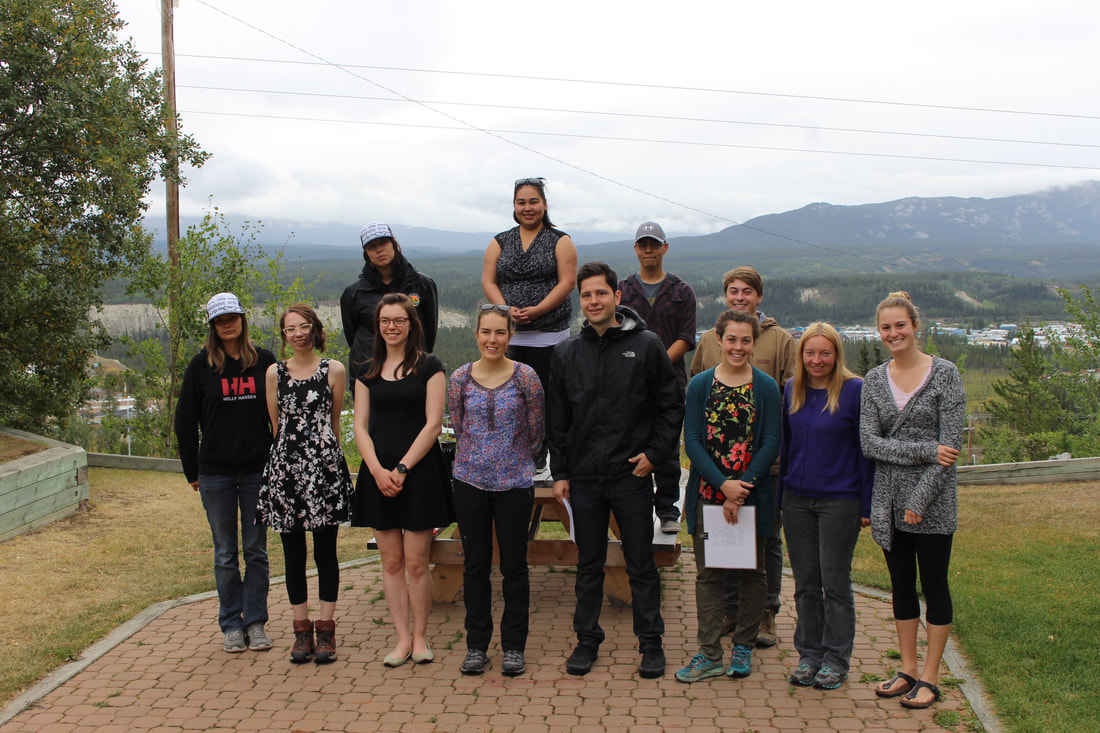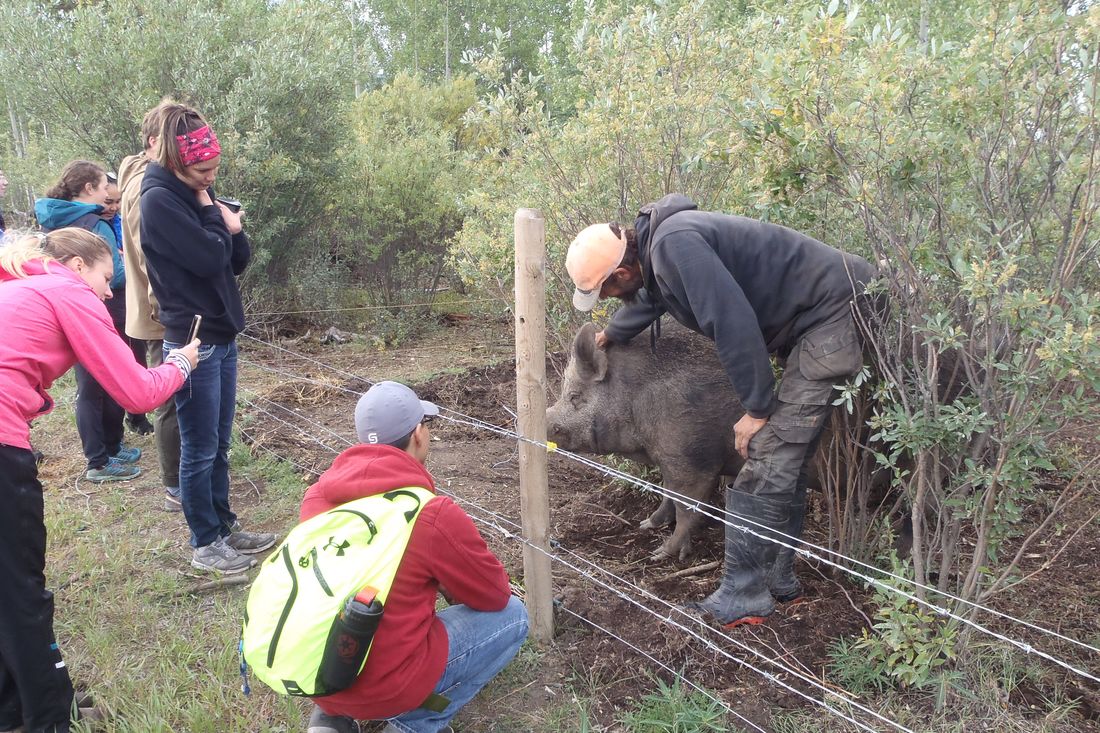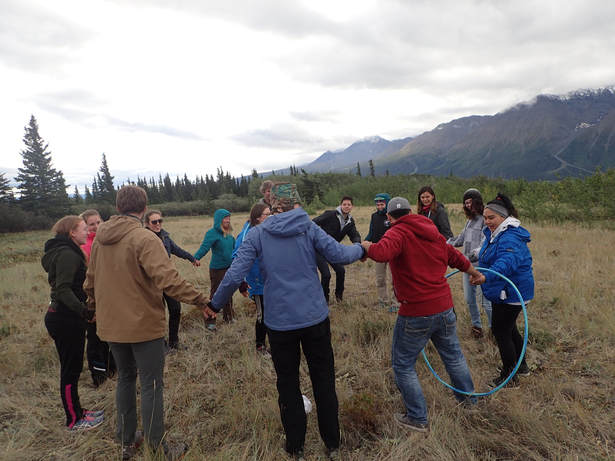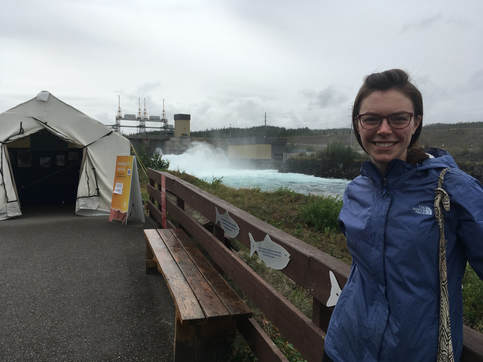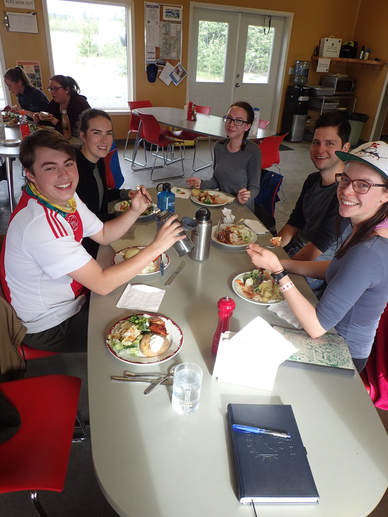|
It’s the seventh and final day of the 2017 Young Leaders’ Summit on Northern Climate Change! We spent the morning packing our gear into the vans and headed off to the Yukon Arts Centre in Whitehorse for our press conference. This event allowed us to share what we learnt throughout the summit and our plans for climate change action with the public. Following our presentation of our declaration, a few participants were interviewed by the press about their experiences, which was aired on the radio.
We then visited the Whitehorse Rapids fish ladder (the longest wooden fish ladder in the world) and learnt fun facts about the Yukon River salmon migration while watching fish swim by. The NWT/Nunavut participants had to catch our flight to Yellowknife so we said goodbye to the Yukon participants and made our last drive of the trip to the Whitehorse airport. We’ve had an amazing week travelling and learning about climate change with an awesome group of individuals! Many thanks to everyone who made this trip a success and who shared their perspectives, stories, and research about climate change with us! Day 6 was our last full day together in the Yukon. We spent the morning of at Elemental Farm, a certified organic farm owned and operated by Bart and Kate, located about 30 minutes outside of Whitehorse. The family’s hard work and commitment to sustainable living in the North was inspiring. For those of us that were interested in starting a home or community garden in our own communities, Bart encouraged us to just dive in and get started with what we have available to us. The success of their farm didn’t come without trial and error, and a lot of hard work.
We spent the afternoon at Ear Lake with Gillian from WWF-Canada, who came to Whitehorse from Inuvik to do a Great Canadian Shoreline Cleanup with our group. It was crazy to see the number of trash bags that were collected in the few short hours that we spent there. My favorite part about this day was the feeling that I, as a young person, could go home to my community and implement the things that we learned about. For the past few years, I have grown a small container garden at my house in Yellowknife. Every year I have expanded bit by bit, and tried growing a few new plants. Over time, I am learning what works and what doesn’t. This process of trial and error is the same thing that Bart and his family have done to grow their farm. Our time spent on Elemental Farm has encouraged me to keep going in that direction. The Shoreline Cleanup is something that all of us can host in our own communities. Participating in cleaning up the shoreline of Ear Lake together promoted a sense of community in our group, and it was great to learn about this opportunity that is accessible to all of us. The activities of the day showed us that going to school and becoming a researcher isn’t the only way to make a difference. There are things that we can get up and do now in our home communities that will have a positive impact. Day 5 of the Summit brought us back to Whitehorse, but not without a few stops along the way. Zoé and Hana from BYTE led us through workshops centered on leadership, communication, and community awareness. We took the David Baum & Associates Leadership Wheel assessment, a tool which assesses your leadership styles during positive and negative scenarios. This self-reflection is an important element of personal growth. Later on we broke into smaller groups to discuss our home communities: what makes our communities strong, what fosters a sense of community, and what positive changes are ongoing to improve engagement. It was a day of personal growth which strengthened our network of young leaders, and helped guide the idea development and writing of our climate change declaration.
To finish off their week-long summit, the young leaders of the 2017 Young Leaders Summit on Northern Climate Change held a press conference at which they made a declaration for climate change action. After their presentation, a few participants got to speak to the press about their experience! They did an awesome job of talking about what they gained through participating in the summit. Listen to their interviews with CBC Radio!
Our first stop of the day was the Da Ku Cultural Centre. Our guide Sheila Kuhniiruk discussed the history of the Champagne and Aishihik First Nations people and their relationships to the park and the land. She showed us traditional tools and clothing used by their people for many years, and reinforced the importance of having respect for the elders and the land, who have guided our growth.
Samuel Turcott provided additional information about Kluane National Park. Did you know that Canada and the US share a 2nd highest peak: St Elias? After a quick visit to Village Bakery, we stopped at Silver City, where we continued a discussion of climate change impacts and what is needed by youth in order to address these issues. Then the dust began to roll in… On the shores of the Kluane Lake and Slims River, we experienced the impact of the receding Kaskawulsh Glacier. With the water dwindling to the Pacific instead of the Bering Sea via Kluane Lake, this has caused the lake and shorelines have receded dramatically! Now, a significant portion of the lake and river bottoms exposed to the Slims Valley winds. The fine glacial sediment now blows, creating large dust clouds, changing the surrounding landscape. At the Kluane Lake Research Station, two researchers from Squirrel Camp shared highlights from their long term research from a monitoring program on the snowshoe hare and red squirrels. They noticed the increased risk to survival as they rely on camouflage to stay hidden from predators. As the seasons cycles become more variable and inconsistent, the hares’ fur doesn’t change with the seasons as it once did. Dr. Matthew Ayre then led us back to the past to discuss his unique research of using old whaling log books to map polar ice caps. Bowhead Whales lived at the edges of ice packs where their food was; therefore these whaling log books are able to be used to create a map of sea ice prior to the existence of satellite imagery. Kwanaschis to all the speakers today! |
Archives
September 2017
Categories |
